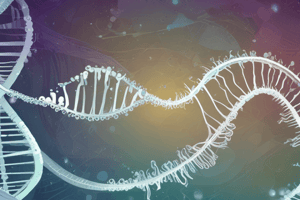Podcast
Questions and Answers
Which DNA structure has a left-handed helix?
Which DNA structure has a left-handed helix?
- B-DNA
- A-DNA
- Cruciform
- Z-DNA (correct)
Which DNA structure can increase the likelihood of double-strand breaks and mutations?
Which DNA structure can increase the likelihood of double-strand breaks and mutations?
- Quadruplex
- B-DNA
- A-DNA
- Triplex (correct)
Which DNA structure consists of quartets stacked on one another, stabilized by hydrogen bonds and cation-dipole interactions?
Which DNA structure consists of quartets stacked on one another, stabilized by hydrogen bonds and cation-dipole interactions?
- A-DNA
- Cruciform
- B-DNA
- Quadruplex (correct)
Which DNA structure is the predominant form in living systems?
Which DNA structure is the predominant form in living systems?
Which DNA structure has 11 bp per helical turn, tilted base pairs, axial hole, and deep major groove?
Which DNA structure has 11 bp per helical turn, tilted base pairs, axial hole, and deep major groove?
Which DNA structure can be formed by inverted repeat sequences?
Which DNA structure can be formed by inverted repeat sequences?
Which DNA structure may exist transiently in cells and play a role in regulating gene expression?
Which DNA structure may exist transiently in cells and play a role in regulating gene expression?
Which DNA structure may form from the G-rich 3′-overhangs of eukaryotic chromosomes and influence chromosome replication and stability?
Which DNA structure may form from the G-rich 3′-overhangs of eukaryotic chromosomes and influence chromosome replication and stability?
What is the purpose of synthesizing homogenous DNA samples that can form crystals?
What is the purpose of synthesizing homogenous DNA samples that can form crystals?
Which of the following is a characteristic of A-DNA?
Which of the following is a characteristic of A-DNA?
Which of the following is the predominant DNA form in living systems?
Which of the following is the predominant DNA form in living systems?
Which of the following is a characteristic of Z-DNA?
Which of the following is a characteristic of Z-DNA?
Which of the following can form a quadruplex structure?
Which of the following can form a quadruplex structure?
Which of the following non-B DNA structures can increase the likelihood of double-strand breaks and mutations?
Which of the following non-B DNA structures can increase the likelihood of double-strand breaks and mutations?
Which of the following non-B DNA structures may form from the G-rich 3′-overhangs of eukaryotic chromosomes and influence chromosome replication and stability?
Which of the following non-B DNA structures may form from the G-rich 3′-overhangs of eukaryotic chromosomes and influence chromosome replication and stability?
Which of the following is true about DNA crystals?
Which of the following is true about DNA crystals?
Which of the following organic chemist discoveries led to the discovery of non-B DNA structures?
Which of the following organic chemist discoveries led to the discovery of non-B DNA structures?
Which of the following non-B DNA structures can be formed by d(CG)3 or d(CA)3 at high salt concentrations and may exist transiently in cells?
Which of the following non-B DNA structures can be formed by d(CG)3 or d(CA)3 at high salt concentrations and may exist transiently in cells?
Flashcards are hidden until you start studying
Study Notes
Non-B DNA Structures: A-DNA, Z-DNA, Cruciform, Triplex, and Quadruplex
- A-DNA is a right-handed double helix with 11 bp per helical turn, tilted base pairs, axial hole, and deep major groove.
- B-DNA is the predominant DNA form in living systems, with 10.5 bp per helical turn, minor and major grooves of similar depths, and no axial hole.
- Z-DNA has a left-handed helix, zigzag sugar-phosphate backbone, and a single groove.
- Z-DNA can be formed by d(CG)3 or d(CA)3 at high salt concentrations, and it may exist transiently in cells and play a role in regulating gene expression.
- Cruciform structure can be formed by inverted repeat sequences, and it consists of double-stranded branches that are somewhat strained compared to normal duplexes.
- Triplex structure can be formed by a third strand in the major groove of DNA, and it can increase the likelihood of double-strand breaks and mutations.
- Quadruplex structure can be formed by one, two, or four G-rich DNA strands, and it consists of quartets stacked on one another, stabilized by hydrogen bonds and cation-dipole interactions.
- Intramolecular quadruplexes may form from the G-rich 3′-overhangs of eukaryotic chromosomes and influence chromosome replication and stability.
- Non-B DNA structures may exist transiently in cells or play a role in regulating gene expression.
- Non-B DNA structures may also be hot spots for DNA double-strand breaks and chromosomal rearrangements that result in malignant diseases.
- DNA crystals can provide information about the distances between specific base pairs, but DNA isolated from natural sources is too heterogeneous to form crystals.
- Organic chemists have developed methods for synthesizing homogenous DNA samples that can form crystals, leading to the discovery of Z-DNA and other non-B DNA structures.
Studying That Suits You
Use AI to generate personalized quizzes and flashcards to suit your learning preferences.




